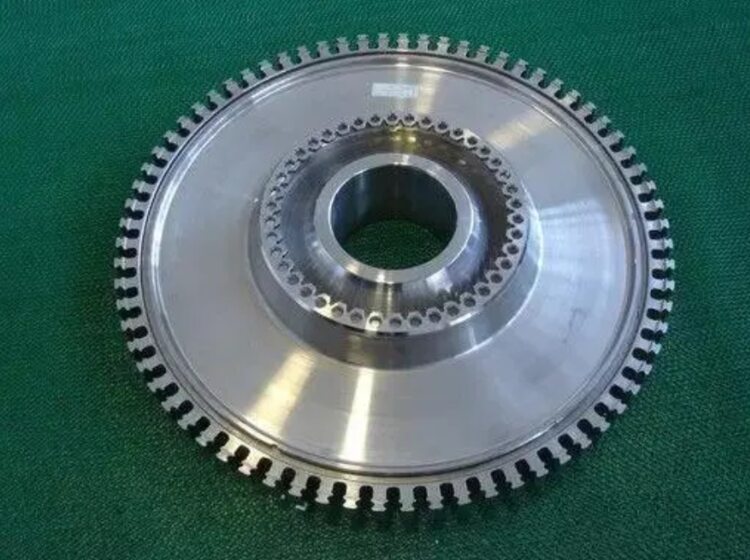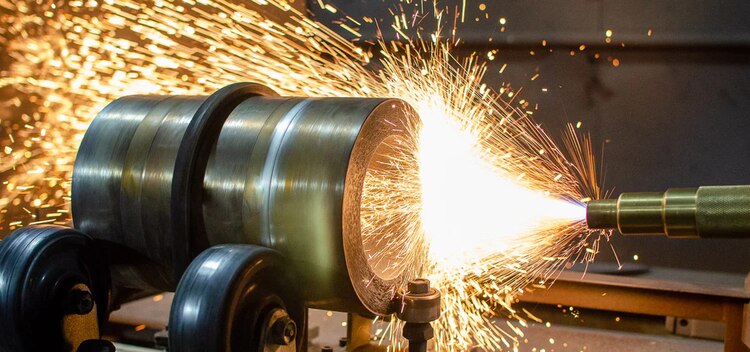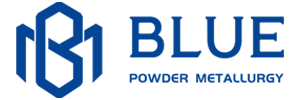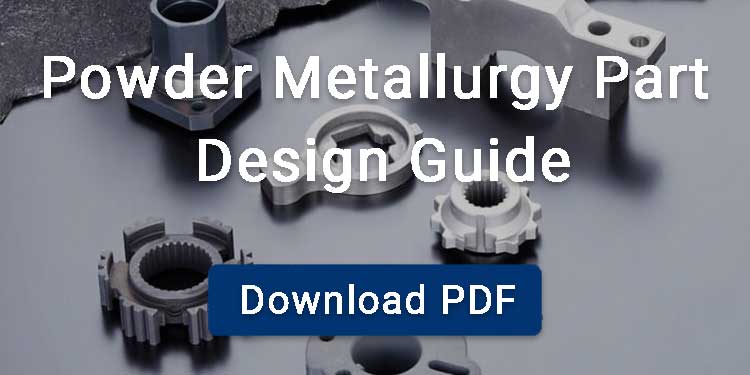You may have heard that powder metallurgy (PM) is widely applied in the mechanical industry.
But do you know about powder metallurgy applications in aerospace?
PM can manufacture high-performance materials and mass-produce complex near net shape parts. This is exactly what aerospace applications need.
Contents
Powder Metallurgy Materials in Aerospace
Superalloys (high-performance alloys)
Do you know super alloy? Superalloys are alloy materials with relatively high melting points, usually based on cobalt or nickel. According to a study of University of Cambridge, superalloys can operate at temperatures around 0.7 times their melting point. This makes them widely used in aviation, aerospace, and medical applications.
Nickel-based superalloys
Nickel-based superalloys are one of the most important materials in aero engines for the following reasons:
- High temperature strength
- Excellent corrosion resistance
- Good fatigue performance

It is mainly utilized to manufacture turbine discs, turbine blades, etc. Through powder metallurgy technology, you can improve the purity and uniformity of nickel-based alloys. And it can also reduce oxygen content and impurities, and boost the strength and toughness of sintered parts.
Common production methods for nickel-based high-performance alloy powders are:
- Gas atomization (GA)
- Electrode induction melting gas atomization (EIGA)
- Plasma rotating electrode process (PREP)
For example, Inconel 625 is ideal for aircraft piping systems and Engine thrust-reverser systems. INCONEL 718 is used in liquid-fuel rocket components and aircraft engine parts due to its ease of fabrication, affordability, and good properties.
Cobalt-based superalloy
Cobalt-based superalloy is another material commonly used in aerospace manufacturing. It plays an important role in manufacturing turbine engines, gas turbines, and other components.
Compared with nickel-based superalloys, cobalt-based superalloys have a higher melting temperature, most of which are above 1300°C. And it has better high temperature corrosion resistance and durability. This makes it employed in the guide vanes of aircraft engines to avoid failures at high temperatures.
The below table is the application of other powder metallurgy superalloys in aero engines.
|
Material Model |
Engine Model |
Part Name |
|
IN 100 |
F100-PW-100 |
Compressor Shroud Ring Turbine disk Turbine Shroud Ring Integrated |
|
F119-PW-100 |
Bladed Rotor (IBR) for Stages 6 to 9 |
|
|
Rene95 |
F101-GE-100 |
Compressor Shaft High-Low |
|
F101-GE-100 |
High-Pressure Turbine Disk |
|
|
F404-GE-400 |
High-Pressure Compressor High-Low Pressure Turbine |
|
|
T700-GE-700 |
Turbine disk |
|
|
Rene88DT |
F101-GE-129 |
Compressor Disk Turbine |
|
CF6-80E |
High-Pressure Turbine Disk |
|
|
CFM56-5C2 |
High-Pressure Turbine |
|
|
GE90 |
9th Stage Compressor Disk |
|
|
U720 |
T800 T406 |
10th Stage Compressor |
|
ME3 |
GP720 |
Turbine Disk |
Titanium alloys
Titanium and titanium alloys, such as Ti-6Al-4V, are widely utilized
in aerospace applications due to the following properties:
- Excellent strength to weight ratio
- Corrosion resistance
- High temperature capability
Titanium alloys are great for manufacturing compressor disks, blades and navigation instruments in aircraft engine fans and compressors. Ti can significantly reduce the weight of the engine by replacing steel, so the thrust-to-weight ratio of the engine can be improved.
Metal Matrix Composite (MMC)
MMC is a composite material of metal and ceramic.
Al/SiC MMC has superior specific strength and stiffness compared to traditional metals like steel or titanium.
It has better thermal stability, which is important for high-temperature applications of turbine blades on aircraft. And MMC has enhanced fatigue resistance, reducing the possibility of failure in aircraft engines under cyclic loading conditions.
Ceramics
Ceramic materials can be used as thermal spray materials to provide thermal protection for aviation parts
Powder Metallurgy Applications in the Aerospace Parts
Turbine blades
Turbine blades made of Al-SiC MMC reduce the fuel consumption of aircraft by reducing weight. This saves costs and brings environmental benefits.
Besides, due to its excellent fatigue resistance, it extends the service life of aircraft engines and reduces maintenance downtime.
Engine Parts

Combustion Chamber
Combustion chambers commonly adopt PM parts due to their high-temperature resistance and ability to withstand thermal cycling.
Fuel nozzles
Powder metallurgy additive manufacturing (3D printing) can provide complex fuel nozzles
According to GE Aerospace, they used additive manufacturing to reduce the number of parts in the fuel nozzles and reduce weight by 25%.
Aircraft brake pads
The core of the aircraft wheel brake device is the brake pad, because during the landing process, the load on the brake pad is very large and the instantaneous surface temperature is also very high.
Powder metallurgy brake pads made of iron powder or copper powder as the main component and non-metallic powders for friction and anti-bonding can meet the above requirements. Now, most military and civilian aircraft use powder metallurgy brake pads.
Other powder metallurgy parts for aircraft engines
- Compressor disc (150 ~ 950mm)
- Thin-walled turbine compressor
- Cylinder shaft
- Hot spray blades
- Injection molded blade adjustment arm for T-406 engine
- Turbine casing;
- Helicopter IN718 guide vane
- Injection molded turbine blade
Thermal Spray Coatings for Aerospace Applications
In addition to parts meeting specific requirements, aerospace engine coating protection is essential. These coatings effectively extend the service life of key engine parts.
Thermal spray powders are commonly used for thermal barrier coatings, sealing coatings, and wear-resistant coatings for aerospace engines.
Common thermal spray powders include:
- Oxide ceramic powder (Al2O3, ZrO2, Cr2O3, TiO2)
- Alloy powder (Al-Ni, Ni-Cr, Ti-Ni, Ni-Cr-Al)
- Metal ceramic powder (WC-Co, Cr3C2-NiCr)
- Pure metal powder (Mo, Al, Cu, Ni, Ti, Ta)
The particle size of thermal spray powder is about 15 to 150μm.
It has the following characteristics:
- Narrow particle size distribution
- High sphericity
- Good fluidity
- Low gas and impurity content
Manufacturers can manufacture these high-precision and pure powders through powder metallurgy atomization technology

Benefits of Powder Metallurgy Parts in Aerospace
Lightweight Components
PM can produce lightweight components using materials including aluminum, titanium, and Al-SiC MMC. This can reduce aircraft fuel consumption.
In China’s aerospace field, the use of titanium-aluminum low-pressure turbine blades can reduce the weight of aircraft engines weighing about 3,000 kilograms by 30 to 50 kilograms, greatly reducing fuel consumption.
Complex Geometries
PM techniques such as powder injection molding (PIM) and hot isostatic pressing (HIP) can make complex shapes and geometries that are difficult or impossible to achieve with traditional machining methods.
High Strength and Durability
Powder metallurgy process allows for the production of materials with tailored properties, such as high strength-to-weight ratios and excellent fatigue resistance.
Cost-Effective Production
Reduced material waste, lower energy consumption, and fewer machining steps.
Heat Resistance
Powder metallurgy technology can produce specific high-temperature resistant materials, particularly the third generation nickel-based high-performance alloy—FGH98.



